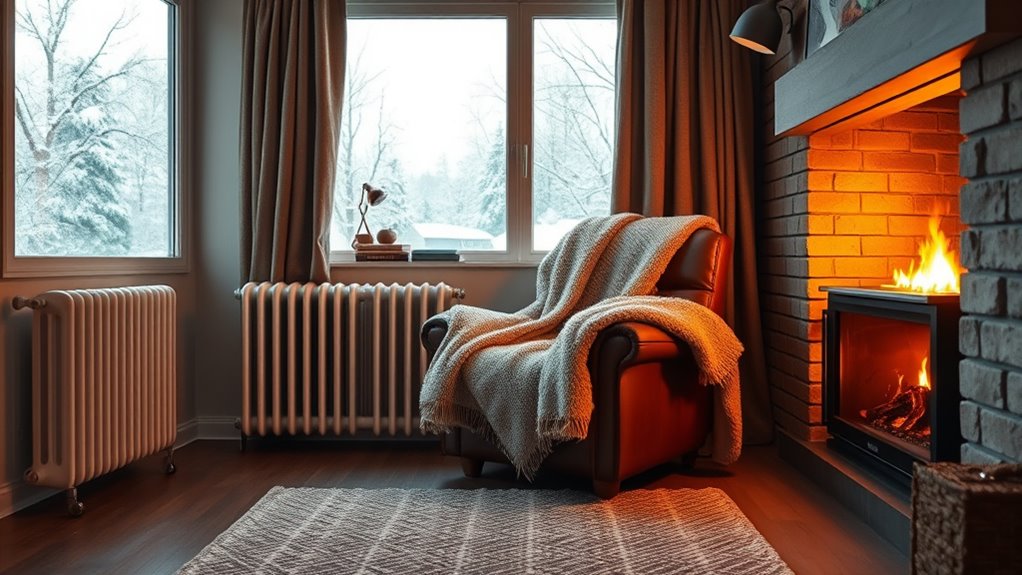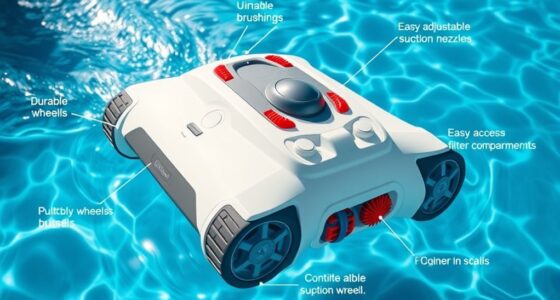To protect your home during winter, focus on improving insulation in your attic, walls, and floors with high R-value materials like foam or fiberglass. Seal leaks around windows and doors with weatherstripping or caulk to prevent drafts. Maintain your heating system by scheduling regular check-ups and updating to energy-efficient units. Add heavy curtains at night for extra warmth. Following these steps will help you stay warm and save on energy costs—explore more tips to keep winter at bay.
Key Takeaways
- Insulate attic, walls, and floors with high R-value materials to prevent heat loss and enhance thermal efficiency.
- Seal leaks around windows and doors with weatherstripping and caulking to block drafts and retain indoor warmth.
- Maintain and upgrade heating systems regularly, using programmable thermostats for precise temperature control.
- Use heavy curtains and window insulation measures at night to reduce heat escape through windows.
- Combine proper insulation with sealing and heating upgrades for a comprehensive winter protection strategy.

Winter weather can be harsh, but with the right precautions, you can stay safe and comfortable. One of the most effective ways to do this is by ensuring your home is well-insulated. Insulation materials are key to keeping warmth inside and cold air out. Check your attic, walls, and floors for adequate insulation, and consider upgrading if it’s insufficient. Proper insulation reduces heat loss, which means your heating system doesn’t have to work as hard to maintain a cozy temperature. This not only saves energy but also cuts down on your utility bills. When selecting insulation materials, look for options with high R-values, as they provide better thermal resistance. Foam board, blown-in cellulose, and fiberglass batts are popular choices that suit different areas of your home. Installing the right insulation is a straightforward step that makes a big difference during the winter months.
Alongside insulation, your heating system plays a vital role in winter weather protection. Make sure your heating system is in top shape before the cold sets in. Schedule maintenance checks to ensure all components are functioning properly, and replace filters regularly to keep airflow unobstructed. Whether you use a furnace, boiler, heat pump, or space heaters, each device needs to be efficient to keep your home warm without wasting energy. If your current heating system is outdated or inefficient, consider upgrading to a newer model with better energy ratings. Modern systems often come with programmable thermostats, allowing you to set temperatures precisely and avoid unnecessary heating when you’re not home or asleep. This not only enhances comfort but also reduces energy costs.
In addition to upgrading your heating system, consider supplementary measures such as sealing leaks around windows and doors. Drafts can substantially lower indoor temperatures, forcing your heating system to compensate. Weatherstripping and caulking are simple, cost-effective ways to prevent heat from escaping. Also, use heavy curtains at night to add an extra layer of insulation over windows. When it comes to heating, the goal is to optimize your system’s efficiency and minimize heat loss. Proper insulation materials combined with a well-maintained, efficient heating system create a formidable barrier against the cold. These steps work together to keep your living space warm, safe, and energy-efficient throughout the winter months. Taking proactive measures now ensures you’ll stay comfortable and avoid costly repairs or energy waste during the coldest part of the year. Additionally, choosing insulation with high R-values can significantly improve your home’s thermal resistance, making your efforts even more effective.
Frequently Asked Questions
How Can I Prevent Frozen Pipes During Winter?
To prevent frozen pipes, you should focus on freeze prevention techniques. Start by pipe insulation, especially on exposed pipes in unheated areas. Keep your home heated to a consistent temperature, even at night. Allowing a small stream of water to flow through the pipes can also help prevent freezing. Additionally, open cabinet doors to let warm air circulate around plumbing, and disconnect outdoor hoses. These steps keep your pipes safe during winter.
What Are the Best Types of Insulation for Attic Spaces?
Think of your attic as a fortress against energy loss. The best insulation materials, like spray foam or fiberglass batts, keep heat in while allowing good attic ventilation. Proper insulation thwarts drafts, but inadequate ventilation can trap moisture. You should install high-quality insulation suited to your attic’s needs and guarantee proper ventilation to maintain an efficient, protected space, reducing your winter energy bills and preventing damage.
How Often Should I Service My Heating System?
You should service your heating system at least once a year to guarantee ideal heating maintenance. Regular servicing helps identify issues early, improving system efficiency and extending its lifespan. If you use your system frequently or have an older model, consider scheduling maintenance more often. Proper heating maintenance not only keeps your home warm but also prevents costly repairs, ensuring your system functions smoothly throughout the winter season.
Are There Eco-Friendly Heating Options for Winter?
Thinking about eco-friendly winter heating? Well, you could always cuddle closer to your electric blanket, or you might explore solar heating and geothermal systems—nature’s own chill busters. Solar heating captures the sun’s warmth, while geothermal systems tap into the Earth’s cozy core. Both options cut your carbon footprint, save energy, and keep you warm without turning the planet into a giant oven. Now, that’s smart winter survival!
How Can I Improve Indoor Air Quality in Cold Months?
To enhance indoor air quality during cold months, focus on regular HVAC maintenance to guarantee your system runs efficiently. Use indoor air filtration with high-quality filters to remove pollutants and allergens. Keep vents clean and replace filters frequently, especially during winter when windows stay closed. Consider adding humidifiers to maintain ideal humidity levels. These steps help create a healthier environment and reduce indoor air pollution, making your home more comfortable and safe.
Conclusion
So, now that you’re armed with exceptional insulation and heating hacks, go ahead—embrace the winter wonderland without the frosty dread. Who knew staying warm could be so easy? Just remember, if your house turns into an igloo, you only have yourself to blame for ignoring these tips. Stay cozy, stay smart, and maybe invest in a good pair of winter boots—because nothing says “prepared” like walking on snow without turning into a human popsicle.








